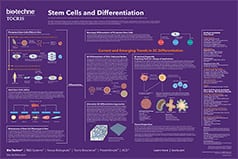TGF-β Receptors
The transforming growth factor-β family of polypeptides (TGF-β1-3) are involved in the regulation of cellular processes, including division, differentiation, motility, adhesion and death. TGF-β signals by binding the type II receptor (TGF-βRII) which activates the type I receptor (TGF-βRI).
TGF-β Receptor Inhibitors |
|
|---|---|
| Cat. No. | Product Name / Activity |
| 6712 | A 77-01 |
| Potent inhibitor of TGF-βRI | |
| 2939 | A 83-01 |
| Selective inhibitor of TGF-βRI, ALK4 and ALK7 | |
| 6870 | AZ 12799734 |
| Potent TGF-βRI inhibitor | |
| 2902 | D 4476 |
| TGF-βRI inhibitor. Also inhibits CK1 | |
| 6956 | Galunisertib |
| ALK4 and ALK5 (TGFβRI) inhibitor | |
| 3264 | GW 788388 |
| Potent and selective inhibitor of TGF-βRI | |
| 6016 | IN 1130 |
| Potent and selective inhibitor of TGF-βRI | |
| 7864 | LY 2109761 |
| Selective TGF-β kinase inhibitor | |
| 5288 | R 268712 |
| Potent and selective inhibitor of TGF-βRI | |
| 3742 | RepSox |
| Potent and selective inhibitor of TGF-βRI | |
| 1614 | SB 431542 |
| Potent, selective inhibitor of TGF-βRI, ALK4 and ALK7 | |
| 3263 | SB 505124 |
| Selective inhibitor of TGF-βRI, ALK4 and ALK7 | |
| 3211 | SB 525334 |
| Selective inhibitor of TGF-βRI | |
| 3269 | SD 208 |
| Potent ATP-competitive TGF-βRI inhibitor | |
| 6245 | SM 16 |
| Potent TGF-βRI inhibitor; orally bioavailable | |
Other |
|
| Cat. No. | Product Name / Activity |
| 5679 | N-Acetylpuromycin |
| Downregulates SnoN and Ski protein expression; promotes TGF-β signaling | |
| 5068 | ITD 1 |
| Selective inhibitor of TGF-β signaling; induces cardiomyocyte differentiation in ESCs | |
| 7830 | Klotho-derived peptide 1 |
| TGF-β receptor 2 (TβR2) binding peptide; disrupts the TGF-β/TβR2 interaction | |
| 2002 | Ro 31-8220 mesylate |
| Induces protein-protein interaction between mutant SMAD4R361H and SMAD3; also PKC inhibitor | |
| 5291 | SIS3 |
| Selective Smad3 inhibitor; inhibits TGF-βR1 signaling | |
Transforming growth factor-β is a cytokine involved in the regulation of many cellular processes, including cell division, differentiation, motility, adhesion and death. There are three known isoforms of TGF-β in mammals, which are synthesized as inactive precursor proteins comprising an N-terminal signal peptide (pre-region), a pro-region known as latency associated peptide (LAP), and a C-terminal region that becomes the active TGF-β molecule. These inactive TGF-β precursors dimerize and are cleaved by proteases. The TGF-β dimers then form small latent complexes (SLCs) by non-covalently binding LAP thereby preventing the binding of TGF-β to its receptor. The cytokine is secreted in this inactive form and associates with latent TGF-β-binding protein (LTBP) to form large latent complexes (LLC), which are incorporated in the extracellular matrix for storage and future mobilization. Latent TGF-β is activated by proteases, thrombospondin-1, reactive oxygen species and integrins.
Active TGF-β signals via transmembrane serine/threonine kinase receptors. There are two TGF-β receptors: type I and type II. Upon activation, the cytokine binds the TGF-β type II receptor (TGF-βRII) triggering the formation of a heterotetrameric complex consisting of two type I and two type II receptors. This induces transphosphorylation and activation of type I by type II receptors. Activated TGF-βRI then in turn phosphorylates a subset of SMAD proteins, Smad2 and Smad3, which translocate to the nucleus where they form transcription complexes with DNA binding factors and co-activators/co-repressors.
TGF-β has an important role in controlling cell differentiation, being implicated in the commitment of stem cells to specific lineages, and is therefore important in the developing embryo. TGF-β inhibitors are widely used in stem cell differentiation protocols for research and regenerative medicine uses. In addition to controlling differentiation of stem cells TGF-β is also implicated in maintaining stemness.
Cancer is another area in which TGF-β is key; it functions as a tumor suppressor by inhibiting the cell cycle in the G1 phase. Administration of TGF-β can protect against mammary tumor development in transgenic mouse models in vivo. Disruption of the TGF-β/Smad pathway has been implicated in a variety of human tumor types, with the majority of colon and gastric cancers being caused by an inactivating mutation of TGF-βRII. Homozygous deletions of TGF-βRI and inactivating mutations of SMAD genes have also been found.
A pro-oncogenic role for TGF-β has also been proposed. Once cells lose their sensitivity to TGF-β1-mediated growth inhibition, autocrine TGF-β signaling can promote tumorigenesis. Elevated levels of TGF-β1 are often observed in advanced carcinomas, and have been correlated with increased tumor invasiveness and disease progression.
In addition, TGF-β is crucial in controlling the immune system, having potent immunosuppressive effects. The cytokine inhibits proliferation of T-lymphocytes and thymocytes, while also promoting differentiation of T-cells. Wound healing is another area in which TGF-β plays an important part, with effects on all stages on the process including inflammation, cell migration, fibroblast proliferation and scar tissue remodeling.
External sources of pharmacological information for TGF-β Receptors :
Literature for TGF-β Receptors
Tocris offers the following scientific literature for TGF-β Receptors to showcase our products. We invite you to request* your copy today!
*Please note that Tocris will only send literature to established scientific business / institute addresses.
Stem Cells Scientific Review
Written by Kirsty E. Clarke, Victoria B. Christie, Andy Whiting and Stefan A. Przyborski, this review provides an overview of the use of small molecules in the control of stem cell growth and differentiation. Key signaling pathways are highlighted, and the regulation of ES cell self-renewal and somatic cell reprogramming is discussed. Compounds available from Tocris are listed.
Pathways for TGF-β Receptors
TGF-β Signaling Pathway
The TGF-β signaling pathway is involved in the regulation of growth and proliferation of cells along with migration, differentiation and apoptosis.TGF-β Receptor Gene Data
| Gene | Species | Gene Symbol | Gene Accession No. | Protein Accession No. |
|---|---|---|---|---|
| TGF-βRI | Human | TGFBR1 | NM_004612 | P36897 |
| Mouse | Tgfbr1 | BC063260 | Q64729 | |
| Rat | Tgfbr1 | NM_012775 | P80204 | |
| TGF-βRII | Human | TGFBR2 | NM_003242 | P37173 |
| Mouse | Tgfbr2 | NM_009371 | Q62312 | |
| Rat | Tgfbr2 | NM_031132 | P38438 | |
| TGF-βRIII | Human | TGFBR3 | NM_003243 | Q03167 |
| Mouse | Tgfbr3 | NM_011578 | O88393 | |
| Rat | Tgfbr3 | NM_017256 | P26342 |



